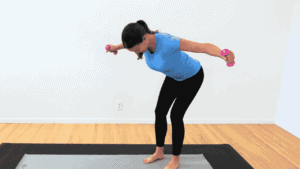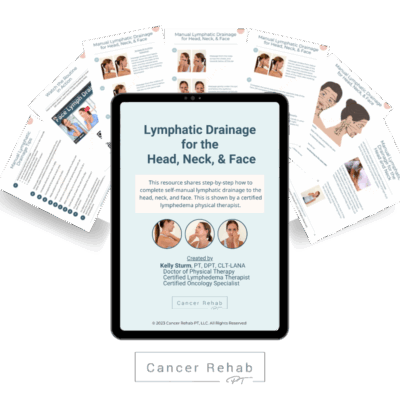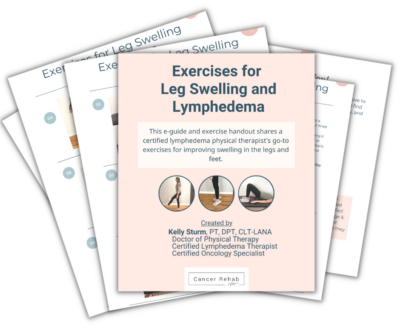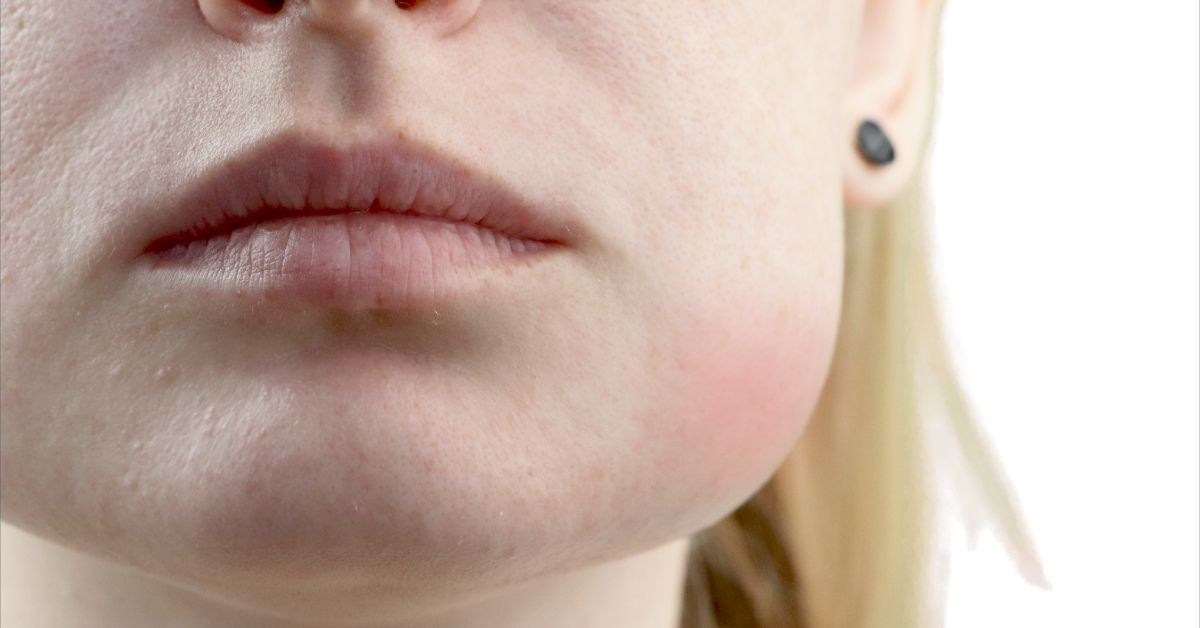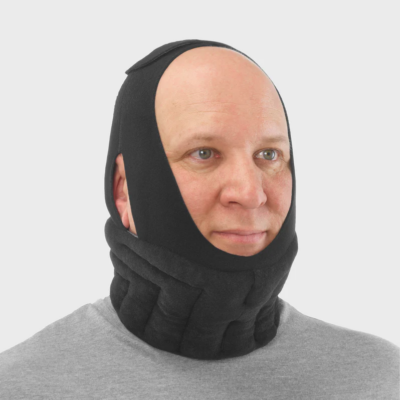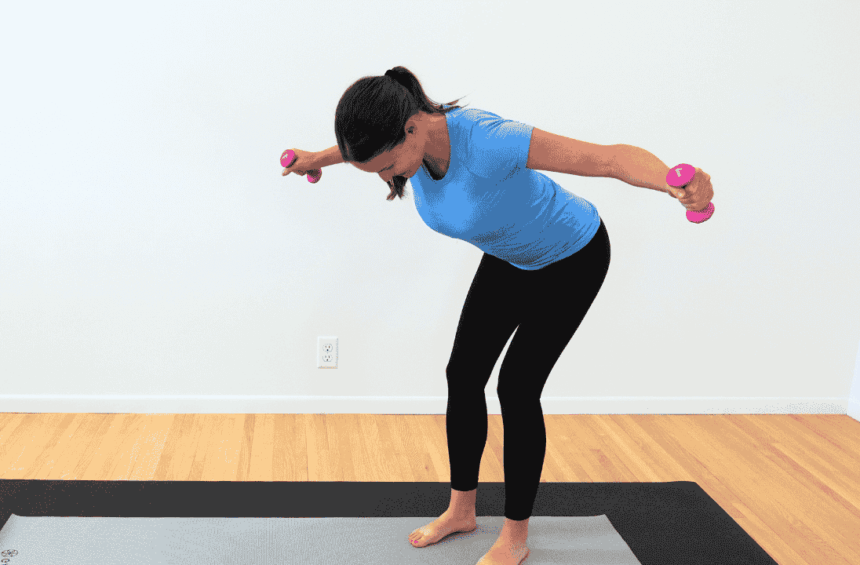Facial swelling is a common issue that many people experience, especially after cancer treatment, plastic surgery, or as part of face or neck lymphedema. This puffiness can also appear when your lymphatic system needs additional support or when certain lifestyle factors come into play.
So, how can you reduce swelling on your face? I’m a certified lymphatic specialist, and I’ll share effective methods to help with a puffy face in this guide.
Why Is My Face Swelling?
Face swelling can happen for many reasons.
- Lymphedema: This happens when fluid builds up because your lymph system isn’t draining properly. Face lymphedema often starts after cancer treatments that take out or harm lymph nodes in your neck.
- Cancer Treatment Effects: Radiation to your head or neck can damage lymph vessels, causing fluid buildup. Often, chemo drugs can also make your body hold onto extra fluid, including in your face.
- After Surgery: If you’ve had plastic surgery like a facelift, nose job, or dental work, swelling is normal during healing. It usually gets better over several weeks.
- Allergic Reactions: Food, medicine, or things in your environment can trigger face swelling. This type of swelling often comes on quickly and might make your skin itchy or red. Severe allergic reactions may require medical attention.
- Infections: Tooth infections, sinus problems, or skin infections can make parts of your face swell.
- Kidney or Thyroid Problems: When these organs aren’t working right, your body might hold onto extra fluid, including in your face.
- Daily Habits: Eating too much salt, drinking alcohol, not sleeping well, and not drinking enough water can all make your face puffy. How you sleep can cause morning face swelling, too.
If your face is swollen after cancer treatment, plastic surgery, or as a result of face or neck lymphedema, the tips in this guide will be especially helpful. But anyone with a puffy face can use these techniques to help their lymph system work better.
How to Reduce Swelling on Face: 7 Things to Try
1. Cold Compress
A cold compress helps reduce face swelling by making blood vessels smaller and slowing down the flow of fluid to the area. This can quickly ease puffiness and inflammation. Cold also numbs the area a bit, which helps if your swelling causes discomfort.
You can use an ice pack, a bag of frozen peas wrapped in a thin towel, or even a chilled spoon. The cool temperature helps tighten the skin temporarily and improve facial puffiness.
2. Elevation
Keeping your head elevated helps drain excess fluid from your face using gravity. When you lie flat, fluid can pool in your face, making swelling worse, especially overnight.
Sleeping with your head propped up on pillows or using a wedge pillow can make a big difference in morning facial puffiness. Even during the day, try to avoid positions where your head is lower than your heart for long periods to reduce puffiness.
3. Lymphatic Drainage Massage
Lymphatic drainage massage is a gentle technique that helps move excess fluid from swollen areas into working lymph vessels. It uses light pressure and rhythmic, circular movements.
This type of massage helps clear congested pathways so your lymph system can work better. If you have a swollen face or struggle with fluid retention, these gentle movements help guide fluid away from puffy areas and toward the lymph nodes in your neck, where it can drain properly.
You can use my Head, Neck, and Face Manual Lymphatic Drainage Guide to reduce swelling.
4. Compression
Compression applies gentle pressure to swollen areas, which helps prevent fluid buildup and supports proper lymph flow. For facial lymphedema, your healthcare provider may recommend special compression garments like face masks or wraps.
These items apply consistent, gentle pressure that helps keep swelling down. Unlike compression for legs or arms, facial compression is usually lighter and designed specifically for the delicate tissues of the face.
These are my recommended compression products for the face and neck as a lymphatic specialist:
5. Dry Brushing
Dry brushing uses a soft, natural-bristle brush on dry skin to stimulate the lymphatic system. This gentle brushing helps wake up your lymph vessels near the skin’s surface.
For facial swelling, you can use very soft brushes made specifically for the face with extremely gentle strokes. This light stimulation helps encourage lymph flow and can reduce puffiness.
You can follow my Dry Brushing to the Neck and Face Printable Guide to dry brush every day or as often as necessary.
6. Exercise
Regular exercise helps pump lymph fluid through your body since the lymph system doesn’t have its own pump like your heart does for blood. Exercise creates muscle contractions that push lymph fluid along its pathway.
Even simple facial exercises and expressions like gentle stretching or yawning widely can help move lymph fluid that’s built up in your face. General body exercise, like walking or swimming, is important too because it improves your overall lymph flow.
Try this rebounder workout for the lymphatic system.
7. Gua Sha
Gua sha is a healing technique that uses a smooth-edged tool, typically made of rose quartz or jade, to gently scrape the skin in upward and outward strokes. This practice helps stimulate the lymphatic system and reduce face puffiness.
Many people find gua sha both effective for reducing minor swelling and relaxing as part of a self-care routine.
How to Reduce Swelling on Face After Surgery
Facial swelling after surgery is normal and part of your body’s healing process. It can develop after plastic surgery, like a facelift or rhinoplasty, dental work, or another procedure in the facial area.
The swelling typically peaks within 48 hours after surgery and then gradually decreases. That said, you can use these approaches to help the swelling go down faster:
- Cold compresses are especially effective in the first 48-72 hours after surgery. Apply the cold pack for 15-20 minutes at a time with breaks in between to reduce immediate post-surgical swelling.
- Keeping your head elevated and positioned above your heart at all times, even while sleeping. You can use 2-3 pillows or a wedge pillow to maintain elevation during the night.
- Gentle lymphatic massage may be recommended by your surgeon, but only after initial healing has occurred. Never massage your face immediately after surgery unless specifically instructed by your healthcare provider.
- Compression garments apply even pressure to support proper healing and reduce swelling, and you can also use them to hold your ice packs.
Always follow your surgeon’s specific post-operative care instructions because they’ll be tailored to your particular procedure and health needs. Most importantly, be patient. Face swelling after surgery will go down, but it can take a few weeks or even months to fully resolve.
Can My Face Swelling Be a Sign of Lymphedema?
Lymphedema is a medical condition that causes chronic swelling. It often develops in the arms or legs, but it can also occur in the face and neck area. It’s sometimes called facial edema.
Face lymphedema is most common after treatments for head and neck cancers, especially when lymph nodes have been removed or damaged by radiation. However, it can also develop due to other injuries or even genetics.
Signs that your facial swelling might be lymphedema include:
- Swelling that doesn’t go away with regular rest or elevation
- A heavy or tight feeling in your face
- Swelling that gets worse throughout the day
- Hardening of the skin over time
- Swelling that doesn’t respond to typical treatments
- Swelling that appeared after cancer treatment involving the head, neck, or face
If you notice these signs, especially after cancer treatment, it’s important to talk to your healthcare provider. Early diagnosis of lymphedema makes it much easier to manage effectively.
Healthy Habits to Help Reduce Swelling on Face
If you regularly deal with a bloated face but don’t have any underlying medical conditions like lymphedema, it could be a sign that your lymphatic system needs more support.
These daily habits help your body process and eliminate excess fluids naturally:
- Drinking water: Staying hydrated helps your body flush toxins and reduces the need to retain fluid.
- Limiting salt intake: High sodium foods cause your body to hold onto extra water.
- Drinking less alcohol: Alcohol causes dehydration and inflammation, leading to facial puffiness.
- Getting enough sleep: Poor sleep affects fluid balance and can make morning selling worse.
- Managing stress levels: Stress hormones can contribute to inflammation and water retention.
- Eating anti-inflammatory foods: Certain foods, such as fresh fruits, whole grains, vegetables, fatty fish, and nuts, can help reduce inflammation.
- Staying active daily: Regular movement helps stimulate lymph flow throughout your body.
- Maintaining a healthy weight: Excess weight puts extra pressure on your lymphatic system.
You don’t need to make all these changes at once, but even small improvements can make a noticeable difference in facial swelling over time.
When Should I Be Worried About Face Swelling?
Most facial swelling is harmless and temporary, but some situations require immediate medical treatment. Don’t ignore these warning signs:
- Swelling appears suddenly and severely, especially after taking a new medication or eating a new food
- Swelling spreads quickly or involves your lips, tongue, or throat
- You have difficulty breathing or swallowing
- Facial swelling is accompanied by hives or an itchy rash
- You experience dizziness, confusion, or feel faint
- The swelling follows a head injury or severe facial trauma
- You have severe pain along with the swelling
- One side of your face suddenly droops or feels numb (possible sign of stroke)
- You have a fever along with facial swelling, especially if there’s redness and warmth
These symptoms could indicate a serious allergic reaction, bacterial infection, or another emergency condition that requires immediate medical attention.
For non-emergency but concerning swelling, contact your healthcare provider if the swelling persists for more than a week without improvement, keeps coming back without a clear cause or other symptoms, and develops after cancer treatment, even years later.
FAQs
Does Ibuprofen Help Reduce Swelling in the Face?
Yes, ibuprofen can help reduce facial swelling for many people. As an anti-inflammatory medication, ibuprofen works by blocking substances in your body that cause inflammation. It can work well for facial swelling that was caused by injury, dental work, or sinus infections.
However, ibuprofen isn’t appropriate for everyone. People with certain medical conditions (like high blood pressure) or who take specific medications should avoid it. For chronic facial swelling or lymphedema, ibuprofen and other nonsteroidal anti-inflammatory drugs aren’t enough or recommended, and at the very least, you’ll need to combine them with other management strategies.
How Long Does It Take for Swelling to Go Down on Face?
It depends on the cause of facial swelling. For example, allergic reactions can improve within hours, but post-surgical swelling can take weeks to get better. Most facial swelling goes down relatively fast with appropriate treatment, but facial lymphedema is chronic and requires ongoing management.
Does Sleeping Reduce Face Swelling?
Quality sleep1 can help reduce facial swelling because it allows your body to process and eliminate excess fluids. That said, how you sleep matters. Sleeping flat often causes more fluid to accumulate in your face overnight, resulting in morning puffiness. For best results, sleep with your head elevated on pillows, aim for 7-8 hours of quality rest, and stay hydrated (but finish drinking water an hour or so before bedtime).
Final Thoughts on Facial Swelling
There are many reasons why your face may be swollen.
Some causes of facial swelling are short-lived and can quickly improve with cold compresses or manual lymphatic drainage.
However, sometimes facial swelling develops because of lymphedema, in which case it can be chronic and require regular management.
You can use my Head, Neck, and Face Manual Lymphatic Drainage Guide and Dry Brushing to the Neck and Face Printable Guide to reduce facial swelling and puffiness.


